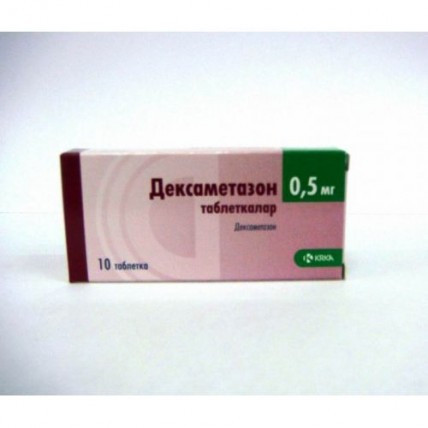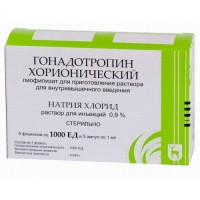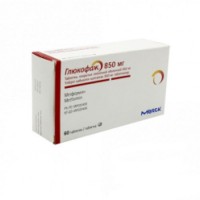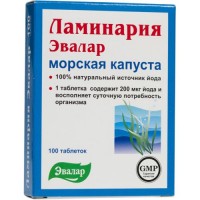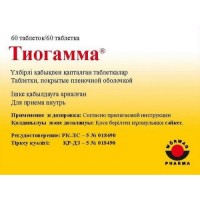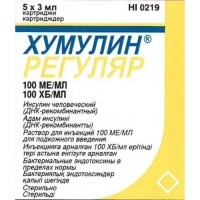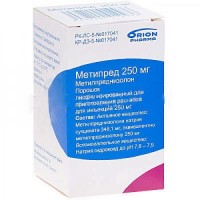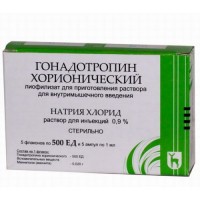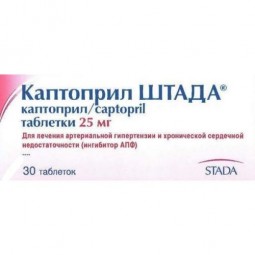Dexamethasone 0.5 mg (10 tablets)
- $3.70
Dexamethasone (tablets of 0.5 mg N10) Slovenia of KRK of d
MNN
Dexamethasone
the Dosage form
of a tablet
the Chemical name
(11th beta, the 16th alpha) - 9 - fluorine - 11, 17, 21 - trigidroks - 16 - a metilpregna - 1, 4 - a diene - 3, 20 - Dion
Pharmacological action
action
of GKS - metilirovanny derivative the ftorprednizolona, slows down release of interleukin-1 and interleukin-2, interferon scale from lymphocytes and macrophages. Renders the anti-inflammatory, antiallergic, desensibilizing, antishock, anti-toxic and immunodepressive effect.
Suppresses release by a hypophysis of AKTG and beta lipotropina, but does not reduce the content of the circulating beta endorphin. Oppresses secretion of TSH and FSG.
Increases excitability of central nervous system, reduces quantity of lymphocytes and eosinophils, increases - erythrocytes (stimulates production of erythropoietins).
Interacts with specific cytoplasmatic receptors and forms the complex getting into a kernel of a cell and stimulates synthesis of mRNK, the last induces formation of proteins, including the lipokortin mediating cellular effects. Lipokortin oppresses A2 phospholipase, suppresses release of arachidonic acid and suppresses synthesis of endoperoxides, Pg, the leukotrienes promoting processes of inflammation, an allergy, etc.
Protein metabolism: reduces amount of protein in plasma (at the expense of globulins) with increase in coefficient albumine/globulin, increases synthesis of albumine in a liver and kidneys, strengthens catabolism of protein in muscle tissue.
Lipidic exchange: increases synthesis of higher fatty acids and TG, redistributes fat (fat accumulation mainly in the field of a shoulder girdle, a face, a stomach), leads ment of a hypercholesterolemia.
Carbohydrate metabolism: increases absorption of carbohydrates from a GIT, increases activity of the glyukozo-6-phosphatase leading to increase in intake of glucose from a liver in blood, increases activity of a fosfoenolpiruvatkarboksilaza and synthesis of the aminotransferases leading to activation of a gluconeogenesis.
Water and electrolytic exchange: Na + and water in an organism detains, stimulates removal of K+ (the ISS activity), reduces absorption of Ca2 + from a GIT, washes away Ca2 + from bones, increases removal of Ca2 + kidneys.
The anti-inflammatory effect is connected with release oppression by eosinophils of mediators of inflammation, induction of formation of a lipokortin and reduction of quantity of the mast cells producing hyaluronic acid with reduction of permeability of capillaries, stabilization of cellular membranes and membranes of organellas (especially lizosomalny).
The antiallergic effect develops as a result of suppression of synthesis and secretion of mediators of an allergy, slowing down of release from sensitized mast cells and basophiles of a histamine, etc. biologically active agents, reduction of number of the circulating basophiles, suppression of development of adenoid and connective tissue, decrease in quantity of T- and B-lymphocytes, mast cells, decrease in sensitivity of effector cells to mediators of an allergy, oppression of antibodyformation, change of the immune response of an organism.
At HOBL the action is based mainly on slowing down of inflammatory processes, oppression of development or prevention of hypostasis of mucous membranes, slowing down of eosinophilic infiltration of a submucosal layer of an epithelium of bronchial tubes, adjournment in a mucous membrane of bronchial tubes of the circulating cell-bound immune complexes and also braking of an erozirovaniye and desquamation of a mucous membrane. Increases sensitivity of beta adrenoceptors of bronchial tubes of small and average caliber to endogenous catecholamines and exogenous sympathomimetics, reduces viscosity of slime due to oppression or reduction of its products.
Antishock and anti-toxic action is connected with increase in the ABP (due to increase in concentration of the circulating catecholamines and recovery of sensitivity to them in adrenoceptors and also vasoconstriction), decrease in permeability of a vascular wall, membranoprotektorny properties, activation of the enzymes of a liver participating in metabolism endo- and xenobiotics.
The immunosuppressive effect is caused by slowing down of release of cytokines (interleykina1, interleykina2, interferon scale) from lymphocytes and macrophages.
Suppresses synthesis and secretion of AKTG and again - synthesis of endogenous GKS. Slows down connective tissue reactions during inflammatory process and reduces a possibility of formation of cicatricial fabric.
Feature of action - considerable inhibition of function of a hypophysis and almost total absence of the ISS of activity. Doses of 1-1.5 mg/days oppress bark of adrenal glands, biological T1/2 - 32-72 h (duration of oppression of a system a hypothalamus-hypophysis-bast layer of adrenal glands).
On GKS force of activity of 0.5 mg of dexamethasone there correspond about 3.5 mg of Prednisonum (or Prednisolonum), 15 mg of a hydrocortisone or 17.5 mg of a cortisone.
The pharmacokinetics
After intake is quickly and completely soaked up, TCmax - 1-2 h. In blood contacts (60-70%) specific protein carrier - transcortinum. Easily passes through gistogematichesky barriers (including through GEB and placentary). It is metabolized in a liver (generally by conjugation with glucuronic and sulfuric acids) to inactive metabolites. It is removed by kidneys (a small part - the lactating glands). T1/2 - 3-5 h.
Indications
General diseases of connective tissue (hard currency, scleroderma, nodular periarteritis, dermatomyositis, pseudorheumatism).
Acute and chronic inflammatory diseases of joints: gouty and psoriasis arthritis, an osteoarthrosis (including posttraumatic), nonspecific tendosinovit polyarthritis, the humeroscapular periarthritis ankylosing a spondylitis (Bekhterev's disease), juvenile arthritis, Steel's syndrome at adults, a bursitis, a synovitis and an epicondylitis.
Rheumatic fever, acute rheumatic carditis.
Bronchial asthma, asthmatic status.
Acute and chronic allergic diseases: allergic reactions to HP and foodstuff, serum disease, small tortoiseshell, allergic rhinitis, Quincke's disease, medicinal dieback, pollinosis.
Skin diseases: a bladderwort, psoriasis, eczema, atopic dermatitis, diffusion neurodermatitis, contact dermatitis (with defeat of a big surface of skin), a toxidermia, seborrheal dermatitis, exfoliative dermatitis, a toxic epidermal necrolysis (Lyell's disease), bullous herpetiform dermatitis, a malignant exudative erythema (Stephens-Johnson's syndrome).
Wet brain (including against the background of a tumor of a brain or connected with surgical intervention, radiation therapy or an injury of the head) after preliminary parenteral use.
Allergic diseases of eyes: allergic helcomas, allergic forms of conjunctivitis.
Inflammatory diseases of eyes: sympathetic ophthalmia, heavy slow lobbies and back uveites, optic neuritis.
Primary or secondary adrenal insufficiency (including a state after removal of adrenal glands).
Congenital adrenal hyperplasia.
Diseases of kidneys of autoimmune genesis (including acute glomerulonephritis), nephrotic syndrome.
Subacute thyroiditis.
Diseases of bodies of a hemopoiesis - an agranulocytosis, a panmyelopathia, autoimmune hemolytic anemia, acute lympho- and myeloid leukoses, a lymphogranulomatosis, a Werlhof's disease, secondary thrombocytopenia at adults, an eritroblastopeniya (erythrocyte anemia), congenital (erythroidal) hypoplastic anemia.
Diseases of lungs: acute alveolitis, pneumosclerosis, sarcoidosis of the II-III St.
Tubercular meningitis, a pulmonary tuberculosis, aspiration pneumonia (in combination with specific chemotherapy).
A berylliosis, Leffler's syndrome (which is not giving in to other therapy).
Lung cancer (in a combination with cytostatics).
Multiple sclerosis.
Gastrointestinal diseases: ulcer colitis, Crohn's disease, local enteritis.
Hepatitis.
Prevention of reaction of graft rejection.
A hypercalcemia against the background of oncological diseases, nausea and vomiting when performing cytostatic therapy.
Multiple myeloma.
Conducting test at differential diagnosis of a hyperplasia (hyperfunction) and tumors of bark of adrenal glands.
Contraindications
For short-term use according to vital indications the only contraindication is the hypersensitivity.
With care
Parasitic and infectious diseases of the virus, fungal or bacterial nature (now or recently postponed, including recent contact with the patient) - the herpes simplex surrounding herpes (viremichesky phase), the chicken pox, measles, the amebiasis, a strongyloidosis (established or suspected), system mycosis, active and latent tuberculosis. Use in serious infectious diseases is admissible only against the background of specific therapy.
Pre- and the vaccine-challenged period (8 weeks to and 2 weeks after vaccination), lymphadenitis after BCZh inoculation. Immunodeficiency (including AIDS or HIV infection).
Gastrointestinal diseases: a peptic ulcer of a stomach and a 12-perstny gut, an esophagitis, gastritis, an acute or latent round ulcer, recently created intestines anastomosis, ulcer colitis with threat of perforation or abscessing, a diverticulitis.
Diseases of CCC, including recently postponed myocardial infarction (at patients with an acute and subacute myocardial infarction the distribution of the center of necrosis, delay of forming of cicatricial fabric and thereof - a rupture of a cardiac muscle is possible), dekompensirovanny HSN, arterial hypertension, a lipidemia.
Endocrine diseases - diabetes (including disturbance of tolerance to carbohydrates), a thyrotoxicosis, a hypothyroidism, Itsenko-Cushing's disease.
Heavy chronic renal and/or liver failure, nefrourolitiaz.
The hypoalbuminemia and states contributing to its emergence.
System osteoporosis, gravis myasthenia, acute psychosis, obesity (III-IV article), poliomyelitis (except for a form of bulbar encephalitis), open and closed-angle glaucoma, the lactation period.
The dosing mode
Inside, in individually selected doses which size is defined by a type of a disease, degree of its activity and the nature of the answer of the patient. An average daily dose - 0.75-9 mg. In hard cases also the high doses divided into 3-4 receptions can be applied. The maximum daily dose - usually 15 mg. After achievement of therapeutic effect the dose is gradually reduced (usually by 0.5 mg in 3 days) to supporting - 2-4.5 mg/days. Minimum effective dose - 0.5-1 mg/days.
To children (depending on age) appoint 83.3-333.3 mkg/kg or 2.5-10 mg/sq.m/days in 3-4 receptions.
Duration of use of dexamethasone depends on the nature of pathological process and efficiency of treatment and is from several days to several months and more. Treatment is stopped gradually (at the end appoint several injections of corticotropin).
In bronchial asthma, a pseudorheumatism, ulcer colitis - 1.5-3 mg/days, at hard currency - 2-4.5 mg/days, in oncohematological diseases - 7.5-10 mg.
For treatment of acute allergic diseases it is reasonable to combine parenteral and oral administration: 1 day - 4-8 mg parenterally, 2 day - inside, 4 mg 3 times a day, 3, 4 day - inside, 4 mg 2 times a day, 5, 6 day - 4 mg/days, inside, 7 day - drug withdrawal.
Test with dexamethasone (Liddl's test). It is carried out in the form of small and big tests. At the small test each 6 h within a day give dexamethasone to the patient on 0.5 mg (i.e. in 8 h morning, in 14 h, 20 h and 2 h morning). I wet for definition 17-OKC or free cortisol collect from 8 h morning to 8 h morning 2 days before prescribing of dexamethasone and also 2 days in the same periods of time after reception of the specified dexamethasone doses. These doses of dexamethasone oppress formation of corticosteroids almost at all almost healthy faces. In 6 h after the last dose of dexamethasone the maintenance of cortisol in plasma is lower than 135-138 nmol/l (less than 4.5-5 mkg / 100 of ml). Decrease in removal 17-OKC is lower than 3 mg/days, and free cortisol lower than 54-55 nmol/days (lower than 19-20 mkg/days) exclude hyperfunction of bark of adrenal glands. At persons with a disease or an Icenco-Cushing syndrome when carrying out the small test of change of secretion of glyukortikosteroid it is not noted.
When carrying out the big test, dexamethasone is appointed on 2 mg by each 6 h during 2 days (i.e. 8 mg of dexamethasone a day). Also carry out collecting urine for definition 17-OKC or free cortisol (if necessary define free cortisol in plasma). In Itsenko-Cushing's disease the decrease in removal 17-OKC or free cortisol for 50% and more is noted while in tumors of adrenal glands or AKTG-ektopirovannom (or kortikoliberin-malrelated) a syndrome removal of corticosteroids does not change. At some patients with AKTG-ektopirovannym a syndrome of decrease in removal of corticosteroids does not come to light even after intake of dexamethasone in a dose of 32 mg/days.
Side effect
the Frequency of development and severity of side effects depend on duration of use, size of the used dose and a possibility of observance of a circadian rhythm of appointment.
From an endocrine system: decrease in tolerance to glucose, steroid diabetes or a demonstration of latent diabetes, oppression of function of adrenal glands, an Icenco-Cushing syndrome (a crescent-shaped face, obesity of hypophysial type, a hirsutism, increase in the ABP, a dysmenorrhea, an amenorrhea, a myasthenia, striya), a delay of sexual development at children.
From digestive system: nausea, vomiting, pancreatitis, steroid ulcer of stomach and 12-perstny gut, erosive esophagitis, bleedings and perforation of a GIT, increase or loss of appetite, meteorism, hiccups. In rare instances - increase in activity of hepatic transaminases and SF.
From CCC: arrhythmias, bradycardia (up to cardiac arrest), development (at predisposed patients) or strengthenings of expressiveness of HSN, ECG change characteristic of a hypopotassemia, increase in the ABP, hypercoagulation, fibrinferments. Patients with an acute and subacute myocardial infarction have a distribution of the center of necrosis, delay of forming of cicatricial fabric that can lead to a rupture of a cardiac muscle.
From nervous system: delirium, disorientation, euphoria, hallucinations, manic-depressive psychosis, depression, paranoia, increase in intracranial pressure, nervousness or concern, insomnia, dizziness, vertigo, cerebellum pseudoneoplasm, headache, spasms.
From sense bodys: a back subkapsulyarny cataract, increase in intraocular pressure with potential damage of an optic nerve, tendency ment of consecutive bacterial, fungal or viral infections of eyes, trophic changes of a cornea, an exophthalmos.
From a metabolism: the increased removal of Ca2+, a hypocalcemia, increase in body weight, negative nitrogenous balance (the increased disintegration of proteins), the increased sweating.
The caused ISS activity - a delay of liquid and Na + (peripheral hypostases), a hypernatremia, a gipokaliyemichesky syndrome (hypopotassemia, arrhythmia, myalgia or a spasm of muscles, unusual weakness and fatigue).
From the musculoskeletal system: delay of growth and processes of ossification at children (premature closing of epiphyseal regions of growth), osteoporosis (it is very rare - pathological bone fractures, aseptic necrosis of a head humeral and a femur), a rupture of sinews of muscles, a steroid myopathy, decrease in muscle bulk (atrophy).
From integuments and mucous membranes: the slowed-down healing of wounds, petechias, ecchymomas, thinning of skin, an atrophy of skin and hypodermic cellulose, hyper - or hypopigmentation, steroid eels, striya, tendency ment of a pyoderma and candidiases.
Allergic reactions: generalized (skin rash, itching of skin, acute anaphylaxis), local allergic reactions.
Other: development or exacerbation of infections (emergence of this side effect is promoted by in common applied immunodepressants and vaccination), a leukocyturia, a withdrawal.
Overdose
Symptoms: strengthening of dose-dependent side effects is possible. In this case the dose of drug should be reduced.
Treatment: symptomatic.
Interaction
Pharmaceutical it is incompatible with other. Hp (can form insoluble compounds).
Dexamethasone increases toxicity of cardiac glycosides (because of the arising hypopotassemia the risk of developing arrhythmias increases).
Accelerates removal of ASK, reduces the maintenance of its metabolites in blood (at dexamethasone cancellation the concentration of salicylates in blood increases and risk of development of by-effects increases).
At simultaneous use with live antiviral vaccines and against the background of other types of immunizations increases risk of activation of viruses and development of infections.
Increases metabolism of an isoniazid, meksiletin (especially at fast acetylizers) that leads to decrease in their plasma concentration.
Increases risk of development of hepatotoxic action of paracetamol (induction of liver enzymes and formation of a toxic metabolite of paracetamol).
Increases (at long therapy) the content of folic acid.
The hypopotassemia caused by GKS can increase expressiveness and duration of muscular blockade against the background of muscle relaxants.
In high doses reduces effect of a somatropin.
Antacids reduce absorption of GKS.
Dexamethasone reduces action of hypoglycemic HP, strengthens anticoagulating action of derivatives of coumarin.
Weakens influence of vitamin D on absorption of Ca2 + in an intestines gleam. Ergocalciferol and parathormone interfere with development of the osteopathy caused by GKS.
Reduces concentration of a prazikvantel in blood.
Cyclosporine (metabolism oppresses) and ketokonazol (reduces clearance) increase toxicity.
Thiazide diuretics, inhibitors of a karboangidraza, other GKS and Amphotericinum B increase risk of development of a hypopotassemia, the Na+-containing HP - hypostases and increase in the ABP.
NPVP and ethanol increase danger of development of an ulceration of a mucous membrane of a GIT of bleeding, in a combination with NPVP for treatment of arthritis GKS dose decline because of summation of therapeutic effect is possible.
Indometacin, forcing out dexamethasone from communication with albumine, increases risk of development of its side effects.
Amphotericinum B and inhibitors of a karboangidraza increase risk of developing osteoporosis.
Therapeutic action of GKS decreases under the influence of Phenytoinum, barbiturates, ephedrine, theophylline, rifampicin, etc. inductors of liver microsomal enzymes (increase in speed of metabolism).
Mitotanum, etc. inhibitors of function of bark of adrenal glands can cause need of increase in a dose of GKS.
The clearance of GKS increases against the background of hormones of a thyroid gland.
Immunodepressants increase risk of developing infections and a lymphoma or other limfoproliferativny disturbances connected with Epstein's virus - Barrel.
Estrogen (including oral estrogensoderzhashchy contraceptives) reduces clearance of GKS, extends T1/2 and their therapeutic and toxic effects.
Emergence of a hirsutism and eels is promoted by simultaneous use of other steroid hormonal HP - androgens, estrogen, anabolic steroids, oral contraceptives.
Tricyclic antidepressants can enhance severity of the depression caused by reception of GKS (are not shown for therapy of these side effects).
Risk of developing a cataract increases at use against the background of other GKS, antipsychotic HP (neuroleptics), carbutamide and Azathioprinum.
Co-administration with m-holinoblokatorami (including antihistaminic HP, tricyclic antidepressants), nitrates contributes to the development of increase in intraocular pressure.
Special instructions
Prior to the beginning of and during GKS of therapy it is necessary to control the general blood test, concentration of glucose and content of electrolytes in plasma.
Appointing dexamethasone in intercurrent infections, septic states and tuberculosis, it is necessary to carry out treatment by bactericidal antibiotics at the same time.
At daily use by 5 months of treatment the atrophy of bark of adrenal glands develops.
Can mask some symptoms of infections, during treatment it is useless to carry out immunization.
At sudden cancellation, especially in case of the previous use of high doses, there is GKS withdrawal (it is not caused by a hypocorticoidism): loss of appetite, nausea, block, generalized musculoskeletal pains, asthenia.
After cancellation within several months the relative insufficiency of bark of adrenal glands remains. If during this period there are stressful situations, appoint (according to indications) for the period of GKS, in need of a combination to the ISS.
At children during long-term treatment the careful observation of dynamics of growth and development is necessary. To children who during treatment were in contact with patients with measles or chicken pox preventively appoint specific Ig.
In the I trimester, in the period of a lactation appoint only according to vital indications, taking into account the expected medical effect and negative influence on a fruit. At long therapy during pregnancy - a fruit growth disorder. In the III trimester of pregnancy - danger of emergence of an atrophy of bark of adrenal glands at a fruit that can demand performing replacement therapy from the newborn.
During treatment by dexamethasone (especially long) observation of the ophthalmologist, control of the ABP and water and electrolytic balance and also a picture of peripheral blood and concentration of glucose in blood is necessary. For the purpose of reduction of by-effects it is possible to appoint anabolic steroids, antacids and also to increase receipt of K+ in an organism (diet, the drugs K+). Food has to be rich K+, proteins, vitamins, with the content of a small amount of fats, carbohydrates and salts.
At children during a growth period of GKS have to be applied only according to absolute indications and under especially careful observation of the attending physician.
MNN
Dexamethasone
the Dosage form
of a tablet
the Chemical name
(11th beta, the 16th alpha) - 9 - fluorine - 11, 17, 21 - trigidroks - 16 - a metilpregna - 1, 4 - a diene - 3, 20 - Dion
Pharmacological action
action
of GKS - metilirovanny derivative the ftorprednizolona, slows down release of interleukin-1 and interleukin-2, interferon scale from lymphocytes and macrophages. Renders the anti-inflammatory, antiallergic, desensibilizing, antishock, anti-toxic and immunodepressive effect.
Suppresses release by a hypophysis of AKTG and beta lipotropina, but does not reduce the content of the circulating beta endorphin. Oppresses secretion of TSH and FSG.
Increases excitability of central nervous system, reduces quantity of lymphocytes and eosinophils, increases - erythrocytes (stimulates production of erythropoietins).
Interacts with specific cytoplasmatic receptors and forms the complex getting into a kernel of a cell and stimulates synthesis of mRNK, the last induces formation of proteins, including the lipokortin mediating cellular effects. Lipokortin oppresses A2 phospholipase, suppresses release of arachidonic acid and suppresses synthesis of endoperoxides, Pg, the leukotrienes promoting processes of inflammation, an allergy, etc.
Protein metabolism: reduces amount of protein in plasma (at the expense of globulins) with increase in coefficient albumine/globulin, increases synthesis of albumine in a liver and kidneys, strengthens catabolism of protein in muscle tissue.
Lipidic exchange: increases synthesis of higher fatty acids and TG, redistributes fat (fat accumulation mainly in the field of a shoulder girdle, a face, a stomach), leads ment of a hypercholesterolemia.
Carbohydrate metabolism: increases absorption of carbohydrates from a GIT, increases activity of the glyukozo-6-phosphatase leading to increase in intake of glucose from a liver in blood, increases activity of a fosfoenolpiruvatkarboksilaza and synthesis of the aminotransferases leading to activation of a gluconeogenesis.
Water and electrolytic exchange: Na + and water in an organism detains, stimulates removal of K+ (the ISS activity), reduces absorption of Ca2 + from a GIT, washes away Ca2 + from bones, increases removal of Ca2 + kidneys.
The anti-inflammatory effect is connected with release oppression by eosinophils of mediators of inflammation, induction of formation of a lipokortin and reduction of quantity of the mast cells producing hyaluronic acid with reduction of permeability of capillaries, stabilization of cellular membranes and membranes of organellas (especially lizosomalny).
The antiallergic effect develops as a result of suppression of synthesis and secretion of mediators of an allergy, slowing down of release from sensitized mast cells and basophiles of a histamine, etc. biologically active agents, reduction of number of the circulating basophiles, suppression of development of adenoid and connective tissue, decrease in quantity of T- and B-lymphocytes, mast cells, decrease in sensitivity of effector cells to mediators of an allergy, oppression of antibodyformation, change of the immune response of an organism.
At HOBL the action is based mainly on slowing down of inflammatory processes, oppression of development or prevention of hypostasis of mucous membranes, slowing down of eosinophilic infiltration of a submucosal layer of an epithelium of bronchial tubes, adjournment in a mucous membrane of bronchial tubes of the circulating cell-bound immune complexes and also braking of an erozirovaniye and desquamation of a mucous membrane. Increases sensitivity of beta adrenoceptors of bronchial tubes of small and average caliber to endogenous catecholamines and exogenous sympathomimetics, reduces viscosity of slime due to oppression or reduction of its products.
Antishock and anti-toxic action is connected with increase in the ABP (due to increase in concentration of the circulating catecholamines and recovery of sensitivity to them in adrenoceptors and also vasoconstriction), decrease in permeability of a vascular wall, membranoprotektorny properties, activation of the enzymes of a liver participating in metabolism endo- and xenobiotics.
The immunosuppressive effect is caused by slowing down of release of cytokines (interleykina1, interleykina2, interferon scale) from lymphocytes and macrophages.
Suppresses synthesis and secretion of AKTG and again - synthesis of endogenous GKS. Slows down connective tissue reactions during inflammatory process and reduces a possibility of formation of cicatricial fabric.
Feature of action - considerable inhibition of function of a hypophysis and almost total absence of the ISS of activity. Doses of 1-1.5 mg/days oppress bark of adrenal glands, biological T1/2 - 32-72 h (duration of oppression of a system a hypothalamus-hypophysis-bast layer of adrenal glands).
On GKS force of activity of 0.5 mg of dexamethasone there correspond about 3.5 mg of Prednisonum (or Prednisolonum), 15 mg of a hydrocortisone or 17.5 mg of a cortisone.
The pharmacokinetics
After intake is quickly and completely soaked up, TCmax - 1-2 h. In blood contacts (60-70%) specific protein carrier - transcortinum. Easily passes through gistogematichesky barriers (including through GEB and placentary). It is metabolized in a liver (generally by conjugation with glucuronic and sulfuric acids) to inactive metabolites. It is removed by kidneys (a small part - the lactating glands). T1/2 - 3-5 h.
Indications
General diseases of connective tissue (hard currency, scleroderma, nodular periarteritis, dermatomyositis, pseudorheumatism).
Acute and chronic inflammatory diseases of joints: gouty and psoriasis arthritis, an osteoarthrosis (including posttraumatic), nonspecific tendosinovit polyarthritis, the humeroscapular periarthritis ankylosing a spondylitis (Bekhterev's disease), juvenile arthritis, Steel's syndrome at adults, a bursitis, a synovitis and an epicondylitis.
Rheumatic fever, acute rheumatic carditis.
Bronchial asthma, asthmatic status.
Acute and chronic allergic diseases: allergic reactions to HP and foodstuff, serum disease, small tortoiseshell, allergic rhinitis, Quincke's disease, medicinal dieback, pollinosis.
Skin diseases: a bladderwort, psoriasis, eczema, atopic dermatitis, diffusion neurodermatitis, contact dermatitis (with defeat of a big surface of skin), a toxidermia, seborrheal dermatitis, exfoliative dermatitis, a toxic epidermal necrolysis (Lyell's disease), bullous herpetiform dermatitis, a malignant exudative erythema (Stephens-Johnson's syndrome).
Wet brain (including against the background of a tumor of a brain or connected with surgical intervention, radiation therapy or an injury of the head) after preliminary parenteral use.
Allergic diseases of eyes: allergic helcomas, allergic forms of conjunctivitis.
Inflammatory diseases of eyes: sympathetic ophthalmia, heavy slow lobbies and back uveites, optic neuritis.
Primary or secondary adrenal insufficiency (including a state after removal of adrenal glands).
Congenital adrenal hyperplasia.
Diseases of kidneys of autoimmune genesis (including acute glomerulonephritis), nephrotic syndrome.
Subacute thyroiditis.
Diseases of bodies of a hemopoiesis - an agranulocytosis, a panmyelopathia, autoimmune hemolytic anemia, acute lympho- and myeloid leukoses, a lymphogranulomatosis, a Werlhof's disease, secondary thrombocytopenia at adults, an eritroblastopeniya (erythrocyte anemia), congenital (erythroidal) hypoplastic anemia.
Diseases of lungs: acute alveolitis, pneumosclerosis, sarcoidosis of the II-III St.
Tubercular meningitis, a pulmonary tuberculosis, aspiration pneumonia (in combination with specific chemotherapy).
A berylliosis, Leffler's syndrome (which is not giving in to other therapy).
Lung cancer (in a combination with cytostatics).
Multiple sclerosis.
Gastrointestinal diseases: ulcer colitis, Crohn's disease, local enteritis.
Hepatitis.
Prevention of reaction of graft rejection.
A hypercalcemia against the background of oncological diseases, nausea and vomiting when performing cytostatic therapy.
Multiple myeloma.
Conducting test at differential diagnosis of a hyperplasia (hyperfunction) and tumors of bark of adrenal glands.
Contraindications
For short-term use according to vital indications the only contraindication is the hypersensitivity.
With care
Parasitic and infectious diseases of the virus, fungal or bacterial nature (now or recently postponed, including recent contact with the patient) - the herpes simplex surrounding herpes (viremichesky phase), the chicken pox, measles, the amebiasis, a strongyloidosis (established or suspected), system mycosis, active and latent tuberculosis. Use in serious infectious diseases is admissible only against the background of specific therapy.
Pre- and the vaccine-challenged period (8 weeks to and 2 weeks after vaccination), lymphadenitis after BCZh inoculation. Immunodeficiency (including AIDS or HIV infection).
Gastrointestinal diseases: a peptic ulcer of a stomach and a 12-perstny gut, an esophagitis, gastritis, an acute or latent round ulcer, recently created intestines anastomosis, ulcer colitis with threat of perforation or abscessing, a diverticulitis.
Diseases of CCC, including recently postponed myocardial infarction (at patients with an acute and subacute myocardial infarction the distribution of the center of necrosis, delay of forming of cicatricial fabric and thereof - a rupture of a cardiac muscle is possible), dekompensirovanny HSN, arterial hypertension, a lipidemia.
Endocrine diseases - diabetes (including disturbance of tolerance to carbohydrates), a thyrotoxicosis, a hypothyroidism, Itsenko-Cushing's disease.
Heavy chronic renal and/or liver failure, nefrourolitiaz.
The hypoalbuminemia and states contributing to its emergence.
System osteoporosis, gravis myasthenia, acute psychosis, obesity (III-IV article), poliomyelitis (except for a form of bulbar encephalitis), open and closed-angle glaucoma, the lactation period.
The dosing mode
Inside, in individually selected doses which size is defined by a type of a disease, degree of its activity and the nature of the answer of the patient. An average daily dose - 0.75-9 mg. In hard cases also the high doses divided into 3-4 receptions can be applied. The maximum daily dose - usually 15 mg. After achievement of therapeutic effect the dose is gradually reduced (usually by 0.5 mg in 3 days) to supporting - 2-4.5 mg/days. Minimum effective dose - 0.5-1 mg/days.
To children (depending on age) appoint 83.3-333.3 mkg/kg or 2.5-10 mg/sq.m/days in 3-4 receptions.
Duration of use of dexamethasone depends on the nature of pathological process and efficiency of treatment and is from several days to several months and more. Treatment is stopped gradually (at the end appoint several injections of corticotropin).
In bronchial asthma, a pseudorheumatism, ulcer colitis - 1.5-3 mg/days, at hard currency - 2-4.5 mg/days, in oncohematological diseases - 7.5-10 mg.
For treatment of acute allergic diseases it is reasonable to combine parenteral and oral administration: 1 day - 4-8 mg parenterally, 2 day - inside, 4 mg 3 times a day, 3, 4 day - inside, 4 mg 2 times a day, 5, 6 day - 4 mg/days, inside, 7 day - drug withdrawal.
Test with dexamethasone (Liddl's test). It is carried out in the form of small and big tests. At the small test each 6 h within a day give dexamethasone to the patient on 0.5 mg (i.e. in 8 h morning, in 14 h, 20 h and 2 h morning). I wet for definition 17-OKC or free cortisol collect from 8 h morning to 8 h morning 2 days before prescribing of dexamethasone and also 2 days in the same periods of time after reception of the specified dexamethasone doses. These doses of dexamethasone oppress formation of corticosteroids almost at all almost healthy faces. In 6 h after the last dose of dexamethasone the maintenance of cortisol in plasma is lower than 135-138 nmol/l (less than 4.5-5 mkg / 100 of ml). Decrease in removal 17-OKC is lower than 3 mg/days, and free cortisol lower than 54-55 nmol/days (lower than 19-20 mkg/days) exclude hyperfunction of bark of adrenal glands. At persons with a disease or an Icenco-Cushing syndrome when carrying out the small test of change of secretion of glyukortikosteroid it is not noted.
When carrying out the big test, dexamethasone is appointed on 2 mg by each 6 h during 2 days (i.e. 8 mg of dexamethasone a day). Also carry out collecting urine for definition 17-OKC or free cortisol (if necessary define free cortisol in plasma). In Itsenko-Cushing's disease the decrease in removal 17-OKC or free cortisol for 50% and more is noted while in tumors of adrenal glands or AKTG-ektopirovannom (or kortikoliberin-malrelated) a syndrome removal of corticosteroids does not change. At some patients with AKTG-ektopirovannym a syndrome of decrease in removal of corticosteroids does not come to light even after intake of dexamethasone in a dose of 32 mg/days.
Side effect
the Frequency of development and severity of side effects depend on duration of use, size of the used dose and a possibility of observance of a circadian rhythm of appointment.
From an endocrine system: decrease in tolerance to glucose, steroid diabetes or a demonstration of latent diabetes, oppression of function of adrenal glands, an Icenco-Cushing syndrome (a crescent-shaped face, obesity of hypophysial type, a hirsutism, increase in the ABP, a dysmenorrhea, an amenorrhea, a myasthenia, striya), a delay of sexual development at children.
From digestive system: nausea, vomiting, pancreatitis, steroid ulcer of stomach and 12-perstny gut, erosive esophagitis, bleedings and perforation of a GIT, increase or loss of appetite, meteorism, hiccups. In rare instances - increase in activity of hepatic transaminases and SF.
From CCC: arrhythmias, bradycardia (up to cardiac arrest), development (at predisposed patients) or strengthenings of expressiveness of HSN, ECG change characteristic of a hypopotassemia, increase in the ABP, hypercoagulation, fibrinferments. Patients with an acute and subacute myocardial infarction have a distribution of the center of necrosis, delay of forming of cicatricial fabric that can lead to a rupture of a cardiac muscle.
From nervous system: delirium, disorientation, euphoria, hallucinations, manic-depressive psychosis, depression, paranoia, increase in intracranial pressure, nervousness or concern, insomnia, dizziness, vertigo, cerebellum pseudoneoplasm, headache, spasms.
From sense bodys: a back subkapsulyarny cataract, increase in intraocular pressure with potential damage of an optic nerve, tendency ment of consecutive bacterial, fungal or viral infections of eyes, trophic changes of a cornea, an exophthalmos.
From a metabolism: the increased removal of Ca2+, a hypocalcemia, increase in body weight, negative nitrogenous balance (the increased disintegration of proteins), the increased sweating.
The caused ISS activity - a delay of liquid and Na + (peripheral hypostases), a hypernatremia, a gipokaliyemichesky syndrome (hypopotassemia, arrhythmia, myalgia or a spasm of muscles, unusual weakness and fatigue).
From the musculoskeletal system: delay of growth and processes of ossification at children (premature closing of epiphyseal regions of growth), osteoporosis (it is very rare - pathological bone fractures, aseptic necrosis of a head humeral and a femur), a rupture of sinews of muscles, a steroid myopathy, decrease in muscle bulk (atrophy).
From integuments and mucous membranes: the slowed-down healing of wounds, petechias, ecchymomas, thinning of skin, an atrophy of skin and hypodermic cellulose, hyper - or hypopigmentation, steroid eels, striya, tendency ment of a pyoderma and candidiases.
Allergic reactions: generalized (skin rash, itching of skin, acute anaphylaxis), local allergic reactions.
Other: development or exacerbation of infections (emergence of this side effect is promoted by in common applied immunodepressants and vaccination), a leukocyturia, a withdrawal.
Overdose
Symptoms: strengthening of dose-dependent side effects is possible. In this case the dose of drug should be reduced.
Treatment: symptomatic.
Interaction
Pharmaceutical it is incompatible with other. Hp (can form insoluble compounds).
Dexamethasone increases toxicity of cardiac glycosides (because of the arising hypopotassemia the risk of developing arrhythmias increases).
Accelerates removal of ASK, reduces the maintenance of its metabolites in blood (at dexamethasone cancellation the concentration of salicylates in blood increases and risk of development of by-effects increases).
At simultaneous use with live antiviral vaccines and against the background of other types of immunizations increases risk of activation of viruses and development of infections.
Increases metabolism of an isoniazid, meksiletin (especially at fast acetylizers) that leads to decrease in their plasma concentration.
Increases risk of development of hepatotoxic action of paracetamol (induction of liver enzymes and formation of a toxic metabolite of paracetamol).
Increases (at long therapy) the content of folic acid.
The hypopotassemia caused by GKS can increase expressiveness and duration of muscular blockade against the background of muscle relaxants.
In high doses reduces effect of a somatropin.
Antacids reduce absorption of GKS.
Dexamethasone reduces action of hypoglycemic HP, strengthens anticoagulating action of derivatives of coumarin.
Weakens influence of vitamin D on absorption of Ca2 + in an intestines gleam. Ergocalciferol and parathormone interfere with development of the osteopathy caused by GKS.
Reduces concentration of a prazikvantel in blood.
Cyclosporine (metabolism oppresses) and ketokonazol (reduces clearance) increase toxicity.
Thiazide diuretics, inhibitors of a karboangidraza, other GKS and Amphotericinum B increase risk of development of a hypopotassemia, the Na+-containing HP - hypostases and increase in the ABP.
NPVP and ethanol increase danger of development of an ulceration of a mucous membrane of a GIT of bleeding, in a combination with NPVP for treatment of arthritis GKS dose decline because of summation of therapeutic effect is possible.
Indometacin, forcing out dexamethasone from communication with albumine, increases risk of development of its side effects.
Amphotericinum B and inhibitors of a karboangidraza increase risk of developing osteoporosis.
Therapeutic action of GKS decreases under the influence of Phenytoinum, barbiturates, ephedrine, theophylline, rifampicin, etc. inductors of liver microsomal enzymes (increase in speed of metabolism).
Mitotanum, etc. inhibitors of function of bark of adrenal glands can cause need of increase in a dose of GKS.
The clearance of GKS increases against the background of hormones of a thyroid gland.
Immunodepressants increase risk of developing infections and a lymphoma or other limfoproliferativny disturbances connected with Epstein's virus - Barrel.
Estrogen (including oral estrogensoderzhashchy contraceptives) reduces clearance of GKS, extends T1/2 and their therapeutic and toxic effects.
Emergence of a hirsutism and eels is promoted by simultaneous use of other steroid hormonal HP - androgens, estrogen, anabolic steroids, oral contraceptives.
Tricyclic antidepressants can enhance severity of the depression caused by reception of GKS (are not shown for therapy of these side effects).
Risk of developing a cataract increases at use against the background of other GKS, antipsychotic HP (neuroleptics), carbutamide and Azathioprinum.
Co-administration with m-holinoblokatorami (including antihistaminic HP, tricyclic antidepressants), nitrates contributes to the development of increase in intraocular pressure.
Special instructions
Prior to the beginning of and during GKS of therapy it is necessary to control the general blood test, concentration of glucose and content of electrolytes in plasma.
Appointing dexamethasone in intercurrent infections, septic states and tuberculosis, it is necessary to carry out treatment by bactericidal antibiotics at the same time.
At daily use by 5 months of treatment the atrophy of bark of adrenal glands develops.
Can mask some symptoms of infections, during treatment it is useless to carry out immunization.
At sudden cancellation, especially in case of the previous use of high doses, there is GKS withdrawal (it is not caused by a hypocorticoidism): loss of appetite, nausea, block, generalized musculoskeletal pains, asthenia.
After cancellation within several months the relative insufficiency of bark of adrenal glands remains. If during this period there are stressful situations, appoint (according to indications) for the period of GKS, in need of a combination to the ISS.
At children during long-term treatment the careful observation of dynamics of growth and development is necessary. To children who during treatment were in contact with patients with measles or chicken pox preventively appoint specific Ig.
In the I trimester, in the period of a lactation appoint only according to vital indications, taking into account the expected medical effect and negative influence on a fruit. At long therapy during pregnancy - a fruit growth disorder. In the III trimester of pregnancy - danger of emergence of an atrophy of bark of adrenal glands at a fruit that can demand performing replacement therapy from the newborn.
During treatment by dexamethasone (especially long) observation of the ophthalmologist, control of the ABP and water and electrolytic balance and also a picture of peripheral blood and concentration of glucose in blood is necessary. For the purpose of reduction of by-effects it is possible to appoint anabolic steroids, antacids and also to increase receipt of K+ in an organism (diet, the drugs K+). Food has to be rich K+, proteins, vitamins, with the content of a small amount of fats, carbohydrates and salts.
At children during a growth period of GKS have to be applied only according to absolute indications and under especially careful observation of the attending physician.
